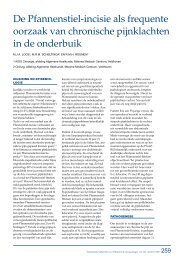Surgical management of chronic inguinal pain syndromes - Liespijn
Surgical management of chronic inguinal pain syndromes - Liespijn
Surgical management of chronic inguinal pain syndromes - Liespijn
Create successful ePaper yourself
Turn your PDF publications into a flip-book with our unique Google optimized e-Paper software.
evaluate if preservation or elective division <strong>of</strong> the <strong>inguinal</strong> nerves during hernia repairwould influence <strong>chronic</strong> <strong>pain</strong> 16-17 . These trials reported inconclusive results. A consecutivedouble-blind randomized controlled trial with one hundred subjects studying aprophylactic neurectomy <strong>of</strong> the ilio<strong>inguinal</strong> nerve during Lichtenstein hernia repairdemonstrated a decreased incidence <strong>of</strong> exertional <strong>chronic</strong> <strong>pain</strong> 18 . The procedure wasneither associated with more neurophysiological abnormalities nor with deteriorationin quality <strong>of</strong> life. Therefore the authors proposed prophylactic ilio<strong>inguinal</strong> neurectomyas a routine surgical step during open mesh hernia repair. From an empirical point <strong>of</strong>view a neurectomy is advisable when the ilio<strong>inguinal</strong> nerve is at high risk <strong>of</strong> entrapmentdue to the placement <strong>of</strong> the mesh. However, larger clinical trials with a longerfollow up period are required.A standard polypropylene mesh is associated with a strong foreign body reactionresulting in the desired abdominal wall strength, but in itself may also act as a probablecause <strong>of</strong> <strong>pain</strong> 19 . Based on this hypothesis Bringman et al. assessed the impact <strong>of</strong> alightweight or standard mesh on <strong>chronic</strong> <strong>pain</strong> with a three-year follow up 20 . The use <strong>of</strong>lightweight mesh (LW) produced less <strong>chronic</strong> <strong>pain</strong>, although the reported differencewas small and only significant during palpation in the groin (standard = 3,3% vs. LW =0,8%). There was no difference in recurrence rate. However, considering increased costs<strong>of</strong> lightweight mesh, these results were not convincing in altering daily surgical practice.The issue <strong>of</strong> <strong>chronic</strong> postherniorrhaphy <strong>pain</strong> has created the dilemma if surgery shouldalways be the preferential treatment in patients with absent or mild symptoms. In apublished series <strong>of</strong> 323 operated patients, those who graded their pre-operative <strong>pain</strong> asmoderate or severe benefited the most <strong>of</strong> their hernia repair, which is in contrast tothose patients who had no <strong>pain</strong> at rest before operation 4 . These latter patients hadsignificant <strong>pain</strong> scores at 1 year. Overall five percent <strong>of</strong> the total study group gradedtheir present <strong>pain</strong> as slightly or much worse compared to their preoperative situation.The question thus rises whether asymptomatic patients should be treated surgicallyat all. A possible answer to this question is given by Fitzgibbons et al. 21 . Their randomizedcontrolled trial showed ‘watchful waiting’ to be an acceptable option for men withminimally symptomatic <strong>inguinal</strong> hernias. Because <strong>of</strong> the low incidence <strong>of</strong> incarceration[1.8/1000 patient-years], delaying surgical repair was considered to be a safe option.In conclusion, the present study shows that <strong>pain</strong> and long-term functional impairmentaffect a large number <strong>of</strong> patients after groin herniorrhaphy in a Dutch teaching hospital.Fortunately, much attention is presently drawn to preventive issues <strong>of</strong> groin <strong>pain</strong>.Surgeons, however, should set up protocols for recognizing and treating these seriousevents. Additional research on the etiology and treatment <strong>of</strong> postherniorrhaphy <strong>pain</strong> isrecommended.APPENDIX QUESTIONNAIRE1 How <strong>of</strong>ten did you experience <strong>pain</strong> in the groin area during the previous month?Never, Occasionally, Regularly, Always2 Please draw an x to indicate the average <strong>pain</strong> intensity in the operated groin areaduring the past month.VAS: No <strong>pain</strong>Unbearable <strong>pain</strong>3 Did you ever notice a bulge in the operated groin area during the past month?Yes, No4 Did you notice a numb feeling in the groin, pubic area or the upper leg during the pastmonth?Yes, No5 Are you functionally impaired in daily activities by your complaints?No, Occasionally, Regularly, Always6 What was the average functional impairment during the past month?None, Mild, Moderate, SevereREFERENCES1 Bay-Nielsen M, Perkins FM, Kehlet H. Pain and functional impairment 1 year after <strong>inguinal</strong>herniorraphy: a nationwide questionnaire study. Ann Surg 2001; 233: 1-72 Callesen T, Bech K, Kehlet H. Prospective study <strong>of</strong> <strong>chronic</strong> <strong>pain</strong> after groin hernia repair. Br J Surg1999; 86: 1528-15313 Poobalan AS, Bruce J, King PM, Chambers WA, Krukowski ZH, Smith WC. Chronic <strong>pain</strong> andquality <strong>of</strong> life following open <strong>inguinal</strong> hernia repair. Br J Surg 2001; 88: 1122-11264 Page B, Paterson D, Young D, O’Dwyer PJ. Pain from primary <strong>inguinal</strong> hernia and the effect <strong>of</strong>repair on <strong>pain</strong>. Br J Surg 2002; 89: 1315-13185 Cunningham J, Temple WJ, Mitchell P, Nixon JA, Preshaw RM, Hagen NA. Cooperative herniastudy: <strong>pain</strong> in the postrepair patient. Ann Surg 1996; 224: 598-6026 Courtney CA, Duffy K, Serpell MG, O’Dwyer PJ. Outcome <strong>of</strong> patients with severe <strong>chronic</strong> <strong>pain</strong>following repair <strong>of</strong> groin hernia. Br J Surg 2002; 89: 1310-13147 Nienhuijs SW, Boelens O, Strobbe LJA. Pain after anterior hernia repair. J Am Coll Surg 2005;200: 885-8898 Liem MSL, Graaf van der Y, Steensel van C, Boelhouwer RU, Clevers GJ, Meijer WS, Stassen LP,Vente JP, Weidema WF, Schrijvers AJ, van Vroonhoven TJ. Comparison <strong>of</strong> conventional anteriorsurgery and laparoscopic surgery for <strong>inguinal</strong> hernia repair. N Engl J Med 1997; 336: 1541-15479 Neumayer L, Giobbie-Hurder A, Jonasson O, Fitzgibbons R Jr, Dunlop D, Gibbs J, Reda D, HendersonW, Veterans Affairs Cooperative Studies Program 456 Investigators. Open mesh versuslaparoscopic mesh repair <strong>of</strong> <strong>inguinal</strong> hernia. N Engl J Med 2004; 350: 1819-182726 Chapter 2Chronic sequelae <strong>of</strong> common elective groin hernia repair 27





